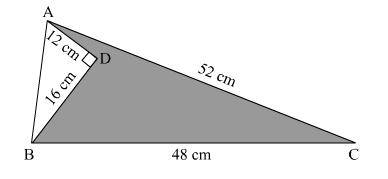Find the area of the shaded region in the figure given below.

In right angled ∆ABD,
$A B^{2}=A D^{2}+D B^{2}$ (Pythagoras Theorem)
$\Rightarrow A B^{2}=12^{2}+16^{2}$
$\Rightarrow A B^{2}=144+256$
$\Rightarrow A B^{2}=400$
$\Rightarrow A B=20 \mathrm{~cm}$
Area of $\triangle A D B=\frac{1}{2} \times D B \times A D$
$=\frac{1}{2} \times 16 \times 12$
= 96 cm2 ....(1)
In ∆ACB,
The sides of the triangle are of length 20 cm, 52 cm and 48 cm.
∴ Semi-perimeter of the triangle is
$s=\frac{20+52+48}{2}=\frac{120}{2}=60 \mathrm{~cm}$
∴ By Heron's formula,
Area of $\Delta A C B=\sqrt{s(s-a)(s-b)(s-c)}$
$=\sqrt{60(60-20)(60-52)(60-48)}$
$=\sqrt{60(40)(8)(12)}$
$=480 \mathrm{~cm}^{2} \quad \ldots(2)$
Now,
Area of the shaded region = Area of ∆ACB − Area of ∆ADB
= 480 − 96
= 384 cm2
Hence, the area of the shaded region in the given figure is 384 cm2.
Click here to get exam-ready with eSaral
For making your preparation journey smoother of JEE, NEET and Class 8 to 10, grab our app now.
